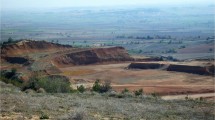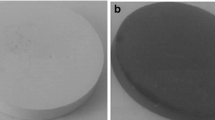Abstract
In this study, the use of rheologically problematic carbonate-bearing clay from the Bilecik and Çanakkale Region of Turkey in porcelain tile bodies was investigated using the dry preparation method. Firstly, the chemical–mineralogical and technological properties of clays were determined, and characterization studies were performed. Then, an attempt was made to determine the optimum usage possibilities by using these raw materials instead of the standard clay-kaolin mixture raw material at the ratios of 10, 20, 30, and 40% in the standard porcelain tile structure. The sintering behavior of the standard bodies, carbonatic clay containing bodies, was studied comparatively using a double-beam optical non-contact dilatometer. Shrinkage (%), water absorption (%), bulk density (gr/cm3), dry strength (N/mm2), flexural strength (N/mm2), and color L, a, b tests were performed on the developed bodies. Mineralogical and phase analyses have been carried out by XRD. The results showed that carbonatic clays, which have rheological problems, could be used in porcelain tiles with dry preparation systems.








Similar content being viewed by others
References
Baraldi, L.: World production and consumption of ceramic tile. Ceram. World Rev. 138, 60–66 (2020)
Sánchez, E., Sanz, V., Cañas, E., Sales, J., Kayacı, K., Taşkıran, M.U., Anıl, Ü.E., Türk, Ş.: Revisiting pyroplastic deformation. Application for porcelain stoneware tile bodies. J. Eur. Ceram. Soc. 39, 601–609 (2019). https://doi.org/10.1016/j.jeurceramsoc.2018.09.032
Shu, Z., Zhou, J., Wang, Y.: A novel approach of preparing press-powders for cleaner production of ceramic tiles. J. Clean. Prod. 18, 1045–1051 (2010). https://doi.org/10.1016/j.jclepro.2010.02.001
Kağan, K.: Investigation of the use of rheological problemed clays of Canakkale region (Turkey) in porcelain tile bodies, Afyon Kocatepe University. J. Sci. Eng.19, 321–325 (2019)
De Paula, S.M., Albers, A.: The effect of borates on the vitrification behavior of a porcelain body. In: Qualicer'02 7th World Congress on Ceramic Tile Quality, pp. 133–137, Spain (2002)
Tarhan, Ş.B.: Kuru öğütme sistemi kullanılarak duvar karosu bünyesi geliştirilmesi, in. Anadolu Üniversitesi (2007)
A. García R, Domínguez-Ríos, C., Bocanegra-Bernal, M.H., Aguilar-Elguézabal, A.: Use of thermally treated bentonitic clay in the formulation of ceramic tiles. Appl. Clay Sci. 46, 271–276 (2009). https://doi.org/10.1016/j.clay.2009.08.016
Dondi, M., Raimondo, M., Zanelli, C.: Clays and bodies for ceramic tiles: reappraisal and technological classification. Appl. Clay Sci. 96, 91–109 (2014). https://doi.org/10.1016/j.clay.2014.01.013
Pal, M., Das, S., Das, S.K.: Anorthite porcelain: synthesis, phase and microstructural evolution. Bull. Mater. Sci. 38, 551–555 (2015)
Pal, M., Das, S., Gupta, S., Das, S.K.: Thermal analysis and vitrification behavior of slag containing porcelain stoneware body. J. Therm. Anal. Calorim. 124, 1169–1177 (2016). https://doi.org/10.1007/s10973-015-5179-7
Carretero, M.I., Dondi, M., Fabbri, B., Raimondo, M.: The influence of shaping and firing technology on ceramic properties of calcareous and non-calcareous illitic–chloritic clays. Appl. Clay Sci. 20, 301–306 (2002). https://doi.org/10.1016/S0169-1317(01)00076-X
Sánchez-Soto, P., Diaz-Hernández, J., Raigón-Pichardo, M., Ruiz-Conde, A., Garcia-Ramos, G.: Ceramic properties of a Spanish clay containing illite, chlorite, and quartz. Br. Ceram. Trans. 93, 196–201 (1994)
Parras, J., Sánchez-Jimeńez, C., Rodas, M., Luque, F.J.: Ceramic applications of Middle Ordovician shales from central Spain. Appl. Clay Sci. 11, 25–41 (1996). https://doi.org/10.1016/0169-1317(96)00003-8
Dana, K., Dey, J., Das, S.K.: Synergistic effect of fly ash and blast furnace slag on the mechanical strength of traditional porcelain tiles. Ceram. Int. 31, 147–152 (2005). https://doi.org/10.1016/j.ceramint.2004.04.008
Kayacı, K.: The use of perlite as flux in the production of porcelain stoneware tiles. Bol. Soc. Esp. Ceram. 60, 283–290 (2020). https://doi.org/10.1016/j.bsecv.2020.03.003
Lach, V.: Microstructural changes during the firing of wall tile and sanitaryware. Ceram. Int. 4, 28–37 (1978). https://doi.org/10.1016/0390-5519(78)90007-8
Montorsi, M., Reginelli, M., Rovini, A., Settembre, D., Siligardi, C., Lugli, C.: Reactivities of carbonates with illite and kaolinite in monoporosa bodies. Ceram. World Rev. 69, 110–120 (2006)
De Noni, A., Hotza, D., Soler, V.C., Vilches, E.S.: Analysis of the development of microscopic residual stresses on quartz particles in porcelain tile. J. Eur. Ceram. Soc. 28, 2629–2637 (2008). https://doi.org/10.1016/j.jeurceramsoc.2008.04.009
Zanelli, C., Raimondo, M., Dondi, M., Guarini, G., Tenorio, P.: Sintering mechanisms of porcelain stoneware tiles. In: 8th World Congress on Ceramic Tile Quality, pp. 247–259 (2004)
Aydın, T.: Investigation of stain resistance of porcelain tiles doped by spodumene, in. Anadolu University, Eskisehir, Turkey (2012)
Bellotto, M., Gualtieri, A., Artioli, G., Clark, S.M.: Kinetic study of the kaolinite-mullite reaction sequence. Part I: Kaolinite dehydroxylation. Phys. Chem. Miner. 22, 207–217 (1995). https://doi.org/10.1007/BF00202253
Gualtieri, A., Bellotto, M., Artioli, G., Clark, S.M.: Kinetic study of the kaolinite-mullite reaction sequence. Part II: Mullite formation. Phys. Chem. Miner. 22, 215–222 (1995). https://doi.org/10.1007/BF00202254
Iqbal, Y., Lee, W.E.: Fired porcelain microstructures revisited. J. Am. Ceram. Soc. 82, 3584–3590 (1999). https://doi.org/10.1111/j.1151-2916.1999.tb02282.x
Martín-Márquez, J., Rincón, J.M., Romero, M.: Effect of firing temperature on sintering of porcelain stoneware tiles. Ceram. Int. 34, 1867–1873 (2008). https://doi.org/10.1016/j.ceramint.2007.06.006
Acknowledgements
The author thanks Dr. Kağan Kayaci and the Kaleseramik Research and Development Center for ceramic tests. The author also acknowledges Prof. Dr. Yasar Ucbas and Mining Engineer Ummet Karahan for providing the sample.
Author information
Authors and Affiliations
Corresponding author
Ethics declarations
Conflict of interest
The author declares no competing interests.
Additional information
Publisher’s note
Springer Nature remains neutral with regard to jurisdictional claims in published maps and institutional affiliations.
Rights and permissions
Springer Nature or its licensor (e.g. a society or other partner) holds exclusive rights to this article under a publishing agreement with the author(s) or other rightsholder(s); author self-archiving of the accepted manuscript version of this article is solely governed by the terms of such publishing agreement and applicable law.
About this article
Cite this article
Gokcen, H.S. The use of rheologically problematic Turkish clays with dry granulation technology in porcelain tile production. J Aust Ceram Soc 59, 555–563 (2023). https://doi.org/10.1007/s41779-023-00851-5
Received:
Revised:
Accepted:
Published:
Issue Date:
DOI: https://doi.org/10.1007/s41779-023-00851-5




